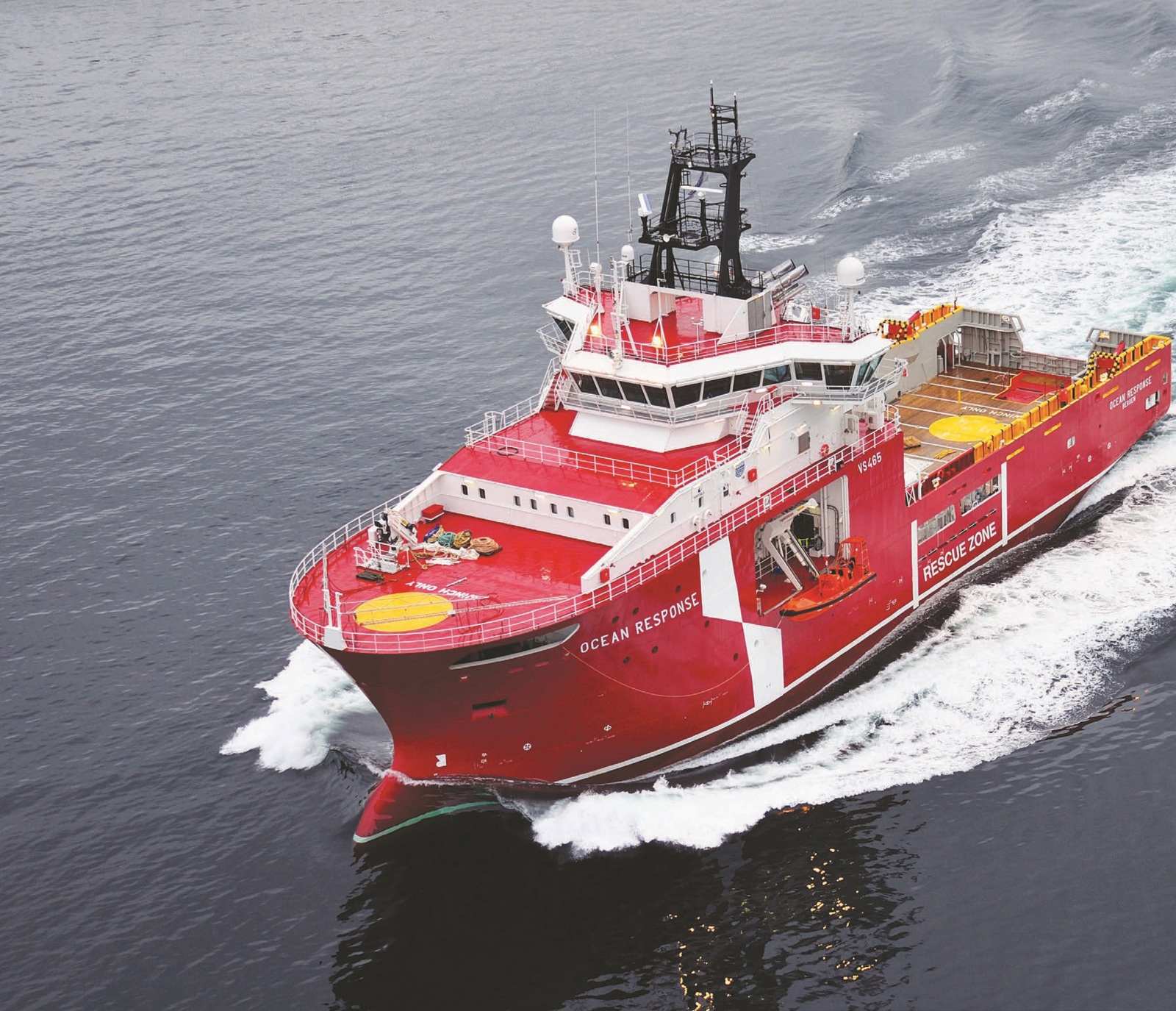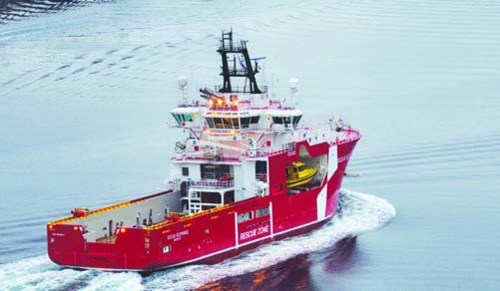
Atlantic Offshore to the rescue
Bergen-based Atlantic Offshore has quickly built a strong position in the niche market segments of field support, standby operations and platform supply. Now, as it looks to consolidate its relationships with oil majors and demonstrate improved environmental credentials, the ambitious business is investing in a fleet renewal programme to acquire cutting edge, and in some cases revolutionary, vessels. Ocean Response, the latest addition to the fleet, is a case in point.
-
Text:Kongsberg Maritime Communication
-
Gunvor Hatling MidtbøVice President, Communications
Roy Wareberg is excited. The CEO of Atlantic Offshore is holding court in the firm’s headquarters in Sotra, near Bergen, Norway and discussing the company’s new Multi-role Rescue Vessel (MRV), Ocean Response. His hands are gesturing rapidly, he’s struggling to contain a grin, and he’s fizzing with energy. One minute he’s sat down, then he’s standing, then he’s grabbing a pen to sketch a configuration of engine blocks on the office whiteboard.
“It’s an incredible vessel,” he remarks of the NOK 330 million purchase, delivered earlier this year from Bergen Shipyards, “a new breed of MRV.”
THE RIGHT RESPONSE
Ocean Response is vessel number 19 in the Atlantic Offshore fleet, with a further six newbuilds scheduled for delivery across the next two years, three of which are MRVs, in addition to three ‘standard’ PSVs. The firm is one of only five players in the North Sea market with more than ten field support (MRV/FSVField Support Vessel) and standby vessels, capable of carrying out a variety of duties such as oil spill response, fire fighting and emergency towing. Its smaller PSV fleet is, as Wareberg puts it, more “commodity” tonnage.
The firm is now looking to secure its leading segment position through fresh investments in high-end tonnage, with the CEO stressing that vessels of the calibre of Ocean Response are a tangible sign of the business’ ambition.
The 75m long, 18m wide, 3824-ton ship is powerful – with 12,000 bhp and a bollard pull of 120 tons – and of high specification, boasting Clean Design and a comfort class notation (Comf-V 3). But there’s something else that is exciting Wareberg today, something that makes the Ocean Response unique.
EFFICIENT SOLUTIONS
The vessel, he explains, is the first of its kind to use a configuration of varying sized Wartsila engines (two of the Wartsila 6L32 models and two 6L20 generating sets) to maximize fuel efficiency and reduce emissions. And the results, Wareberg states, are startling:
“The vessel has a older sister ship called the Ocean Troll (an AHTS). It has the same power output, the same bollard pull and is the same size. However, the emissions are a staggering 90% lower for the new vessel.”
This is achieved predominantly through the engine arrangement, he says, which also delivers huge cost efficiencies, with only approximately 40% of the fuel (compared to the older vessel) used on a like-for-like basis.
He reveals how this is achieved: “In the Troll we have four engines of the same size, approximately 3,000 bhp, whereas in Ocean Response we have four engines of varying size linked by a power management system that chooses what engine, or configuration of engines, to call upon dependent on the power that is required.
“This means that at any given moment you have only the bhp you need not just increments of 3,000 (dependent on the number of engines employed in The Troll). It’s sensational.”

Wareberg admits that he was “a little nervous” about the project initially, as the firm were the first to try this with Wartsila engines, but says that the vessel is “performing above all expectations” – an observation that causes his smile to get a little wider still.
DYNAMIC IMPACT
And so it should. Ocean Response’s innovative approach to engine, fuel and environmental management isn’t just impressing Wareberg, it’s also finding favour with Norwegian oil major Statoil, which has engaged the ship on a 15-year long time-charter agreement.
The vessel is now operating in the North Sea in the area of the Gullfaks field, where it is undertaking, and on standby to under-take, a diverse array of critical MRV and PSV assignments. These include performing specialist maintenance tasks on the network of submerged hoses/pipes that Statoil uses to transfer oil to shuttle tankers, supplying installations (carrying everything from containers to boats), fire fighting, personnel rescue duties, oil spill response and recovery operations, and, if necessary, towing (where the aforementioned 120 ton bollard pull capacity is a real boon).
Alongside the innovations in the engine room, this huge range of activity the ship is custom built to undertake – in the often unforgiving waters of the North Sea – led to Atlantic Offshore investing in cutting edge Kongsberg Maritime dynamic positioning technology (DP II) to ensure impeccable station-keeping operations.
Atlantic Offshore Project Manager Stein Hauger explains more: “When there is a need for DP on our vessels they tend to have KONGSBERG technology installed. It’s a system that we have both extensive experience of and confidence in.”

“The vessel has an older sister ship called the Ocean Troll (an AHTS). It has the same power output, the same bollard pull and is the same size. However, the emissions are a staggering 90% lower for the new vessel“ - Roy Wareberg, CEO, Atlantic Offshore
THE PREREQUISITE FOR SUCCESS
Hauger says that reliable DP is absolutely essential – he calls it “a prerequisite” – for carrying out the type of activity undertaken by the Ocean Response.
“It goes almost without saying that DP is crucial when you’re operating in close proximity to the platforms, charging and discharging cargo for example. But with a vessel like this one, there are further requirements.”
The maintenance of the hoses, for which the Ocean Response has been optimised, is a key consideration he says. Statoil has specially trained personnel aboard the vessel to service these transfer tubes, which have complicated electronic systems at the connection hubs. The hose ends have to be brought on board the ship using a special arrangement at the stern of Ocean Response, enabling the Statoil team to maintain the electronics. However, their robust nature makes them difficult to move/bend. “It’s therefore essential,” Hauger stresses, “to maintain position, making it possible for the team to carry out these critical operations.”
Moving away from such ‘everyday’ duties, DP also comes heavily into play in emergency situations. The vessel has an advanced firefighting class notation of FiFi II, meaning it is fitted with a minimum of two powerful fire ‘monitors’ that can throw water to a minimum distance of 180m from the ship and to a height of 110m (the total water distribution capacity for this class is ‘not less than 7200m3/h’). “These monitors are very powerful,” Hauger imparts, “and essentially act as water jets, meaning they can have a huge impact on the vessel’s positioning, which is obviously critical in emergency situations. “We therefore need to use the engines/thrusters to compensate, which is where the KONGSBERG DP system comes into its own.”
With so much at stake, making mistakes is simply not an option and Atlantic Offshore is rapidly establishing a reputation as a reliable ‘go to’ partner for firms of the order of Statoil, Shell, Total and ConocoPhillips. Thanks to high-end new vessels such as Ocean Response, the firm’s already leading position in this niche segment looks set to grow stronger. Something that should make CEO Mr Wareberg even more excited.